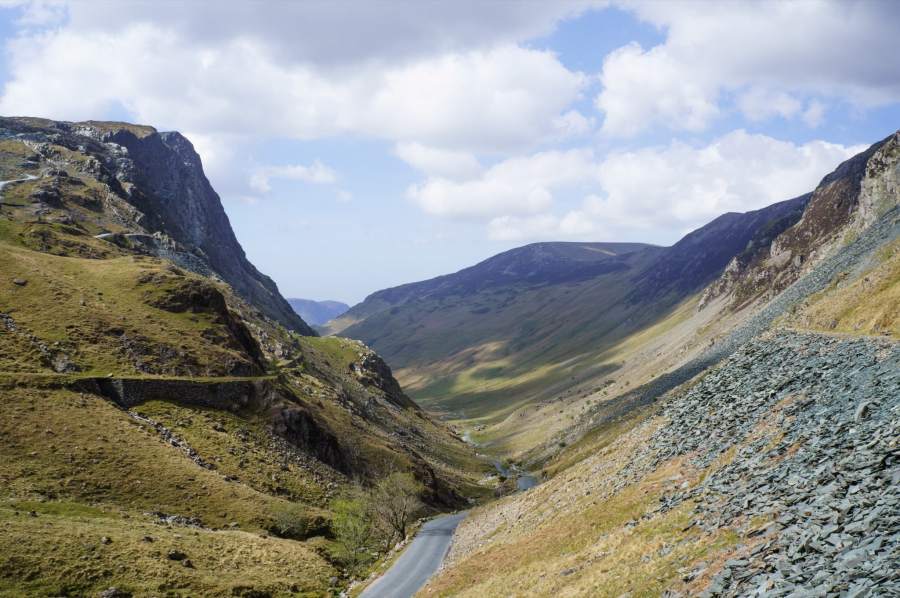The Lake District National Park Authority’s development control committee have granted permission for a 1km-long zip wire in the Lake District, subject to conditions being agreed.
Although planning officers at Murley Moss had recommended refusal, the committee voted 7–3 in favour of the scheme. Some members of the committee put forward the argument that the Honister area was already heavily developed, with a history of industry, and that visitors did not go there to seek out peace and tranquillity.
Permission has twice before been refused for zip wire development at Honister Slate Mine, in 2011 and 2012. The project will also be used to move quarried stone from an inaccessible area on the mountainside back down to the workshop.
While some might claim that this development is hardly in the same league as the proposed Thirlmere zip wire plan – which would have spanned an entire lake – it’s hard to ignore the bigger picture. As more commercial developments are allowed to go ahead within the National Park, nature and conservation get increasingly sidelined. As a society it’s time for us to think about what National Parks are really for.
Biodiversity impacts
Friends of the Lake District have been campaigning against the zip wire proposal for some time. In a statement, Friends of the Lake District said:
“Friends of the Lake District considers there to be little justification for the Lake District National Park Authority Members ignoring the advice of its Planning Officer and agreeing to this development. We consider this to be a highly sensitive location and that this development will have a detrimental impact on the landscape character, tranquillity and biodiversity of the area.
“we feel that the application failed to provide sufficient information regarding the potential number of users”
“Both lines are intended to be used for the movement of stone and the shorter line is to be accessible for all including those who may not be able to access the full via ferrata. The applicant contends that the new uses outweigh the detrimental impacts of the proposal. Whilst the two proposed new uses of the wire are commendable in terms of supporting the existing business use of the site and providing a new experience in the Lake District which is accessible for all, in our opinion, they do not outweigh the detrimental impacts of the scheme.
“We consider the zip wire to be an inappropriate addition to the offering which will result in unacceptable detrimental landscape impacts.
“Our main concerns are:
- “The conflicts with the National Park purposes
- “The landscape and visual impacts of the development in this high fell landscape
- “Impacts upon tranquillity by means of incongruous noise and movement at the site
- “Transport impacts on the local road network
- “Potential impacts upon open access land.
“Additionally, we feel that the application failed to provide sufficient information regarding the potential number of users, particularly on the additional shorter line. Whilst the capacity of the ‘main’ line is limited by the numbers of people completing the via ferrata there will be no such restriction on the shorter line and it is likely to become a popular attraction in its own right. The application did not address this issue and we are now concerned that this development will intensify the tourism and recreation activity on the site and create additional noise and traffic impacts.
“We also have major concerns relating to the potential for adverse impacts on international biodiversity designations; concerns shared by Natural England in its response to this application.”
Inappropriate locations
Campaign group Zip Off, who were instrumental in opposing the planned Thirlmere zip wire scheme, have also provided a statement on today’s decision.
“The Zip Off Campaign is disappointed in the decision of the Lake District National Park Authority planning committee to permit the development of zip wires at the Honister Pass. We feel this decision threatens the World Heritage status of the National Park, and completely ignores the Sandford Principle which mechanism was designed to dissuade planners from decisions such as these today.
“We consider the Honister site as completely inappropriate on account of the road access via both Borrowdale and Buttermere being completely insufficient to accommodate increased traffic for a tourist attraction. Unlike the existing via ferrata, which requires a suitable level of fitness and experience, the zip wires require zero skill, so could attract unsustainable numbers and traffic issues.
“the ethical and moral authority of the LDNPA is sadly drawn into question”
“We also oppose the decision on the grounds that the Honister company did not supply the detailed business plan that was required to support the financial sustainability plans for this project. Now we learn that contrary to initial reports that wires would be shared by quarrying stone transport and zip liners, one of the wires will be dedicated just to zip wire tourists. We believe there are grounds for an appeal against this planning decision, and are seeking advice on this.
“Lastly, we reiterate that we are not against all zip wires, but are against their installation in inappropriate locations. There are far more suitable potential places around the southern and western fringes of the National Park , which have better transport access, and which would provide much needed jobs in these regions. Today is a very sad day for the National Park, and the ethical and moral authority of the LDNPA is sadly drawn into question.”
Header image © Natasha Z / Shutterstock








